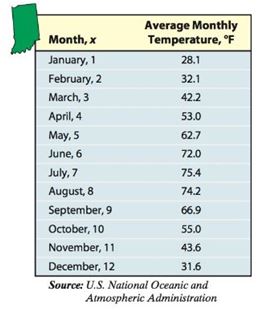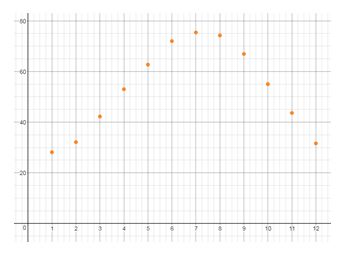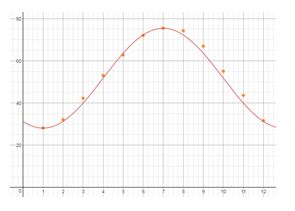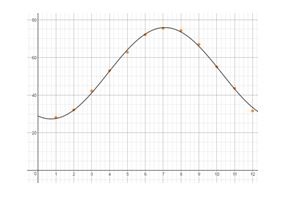
Monthly Temperature The given data represent the average monthly temperatures for Indianapolis, Indiana.
(a) Draw a
(b) Find a sinusoidal function of the form that models the data.
(c) Draw the sinusoidal function found in part on the scatter diagram.
(d) Use a graphing utility to find the sinusoidal function of best fit.
(e) Graph the sinusoidal function of best fit on a scatter diagram of the data.

To find:
a. Draw a scatter diagram of the data.
Answer to Problem 31AYU
a.

Explanation of Solution
Given:
Calculation:
a. Draw a scatter diagram of the data.

To find:
b. Find a sinusoidal function of the form that models the data.
Answer to Problem 31AYU
b.
Explanation of Solution
Given:
Calculation:
b. Find a sinusoidal function of the form that models the data.
Determine , the amplitude of the function.
Determine , the vertical shift of the function.
Determine , It is easier to find the horizontal stretch factor first. Since the period of the function is . Because . Therefore .
Now superimpose the graph of on the scatter diagram. See Figure, where it is clear that the graph still needs to be shifted horizontally.
Determine the horizontal shift of the function by using the period of the data. we must shift the graph of the function.
At ,
To find:
c. Draw the sinusoidal function found in part (b) on the scatter diagram.
Answer to Problem 31AYU
c.

Explanation of Solution
Given:
Calculation:
c. Draw the sinusoidal function found in part (b) on the scatter diagram.

To find:
d. Use a graphing utility to find the sinusoidal function of best fit.
Answer to Problem 31AYU
d.
Explanation of Solution
Given:
Calculation:
d. Use a graphing utility to find the sinusoidal function of best fit.
To find:
e. Graph the sinusoidal function of best fit on a scatter diagram of the data.
Answer to Problem 31AYU
e.

Explanation of Solution
Given:
Calculation:
e. Graph the sinusoidal function of best fit on a scatter diagram of the data.

Chapter 6 Solutions
Precalculus Enhanced with Graphing Utilities
Additional Math Textbook Solutions
Introductory Statistics
A First Course in Probability (10th Edition)
College Algebra (7th Edition)
Thinking Mathematically (6th Edition)
Calculus for Business, Economics, Life Sciences, and Social Sciences (14th Edition)
- Find the following limit lim x-4 X-72 3x-6arrow_forwardFind the one sided limit Tim f(x) where f(x)= (2x-1 X>1+ *arrow_forwardFind the limit lim X-700 4 13x-15 3x4+x³-12arrow_forwardFind the slope of the line secant to the curve F(x) = 13-x³ (from x=1 to x=2]arrow_forwardFind the ONe sided limit lim 2x X-2 1-xarrow_forwardFor each function, identify all points of discontinuity and label them as removable, jump, or infinite. A) f(x) = x-4 (X+15)(x-4) B) f(x) = (x²-1 x ≤2 14-2x 2arrow_forwardFind the one sided limit 2 lim Flx) where f(x) = (x²-4_xarrow_forwardRequired information A telephone cable is clamped at A to the pole AB. The tension in the left-hand portion of the cable is given to be T₁ = 815 lb. T₁ 15° A 25° T₂ I B Using trigonometry, determine the corresponding magnitude of R. The corresponding magnitude of R is lb.arrow_forwardTwo forces are applied as shown to a hook support. The magnitude of P is 38 N. 50 N 25° DC a Determine the corresponding magnitude of R. The magnitude of R is N.arrow_forwardLet y(t) represent your retirement account balance, in dollars, after t years. Each year the account earns 7% interest, and you deposit 8% of your annual income. Your current annual income is $34000, but it is growing at a continuous rate of 2% per year. Write the differential equation modeling this situation. dy dtarrow_forwardDetermine Whether series converge or diverge if it converge what is the limit. $\{ \frac {(-1)^{n-2}n^{2}}{4+n^{3}}\} _{n=0}^{\infty }$arrow_forwardLet y(t) represent your retirement account balance, in dollars, after t years. Each year the account earns 7% interest, and you deposit 8% of your annual income. Your current annual income is $34000, but it is growing at a continuous rate of 2% per year. Write the differential equation modeling this situation. dy dtarrow_forwardarrow_back_iosSEE MORE QUESTIONSarrow_forward_iosRecommended textbooks for you
 Calculus: Early TranscendentalsCalculusISBN:9781285741550Author:James StewartPublisher:Cengage Learning
Calculus: Early TranscendentalsCalculusISBN:9781285741550Author:James StewartPublisher:Cengage Learning Thomas' Calculus (14th Edition)CalculusISBN:9780134438986Author:Joel R. Hass, Christopher E. Heil, Maurice D. WeirPublisher:PEARSON
Thomas' Calculus (14th Edition)CalculusISBN:9780134438986Author:Joel R. Hass, Christopher E. Heil, Maurice D. WeirPublisher:PEARSON Calculus: Early Transcendentals (3rd Edition)CalculusISBN:9780134763644Author:William L. Briggs, Lyle Cochran, Bernard Gillett, Eric SchulzPublisher:PEARSON
Calculus: Early Transcendentals (3rd Edition)CalculusISBN:9780134763644Author:William L. Briggs, Lyle Cochran, Bernard Gillett, Eric SchulzPublisher:PEARSON Calculus: Early TranscendentalsCalculusISBN:9781319050740Author:Jon Rogawski, Colin Adams, Robert FranzosaPublisher:W. H. Freeman
Calculus: Early TranscendentalsCalculusISBN:9781319050740Author:Jon Rogawski, Colin Adams, Robert FranzosaPublisher:W. H. Freeman
 Calculus: Early Transcendental FunctionsCalculusISBN:9781337552516Author:Ron Larson, Bruce H. EdwardsPublisher:Cengage Learning
Calculus: Early Transcendental FunctionsCalculusISBN:9781337552516Author:Ron Larson, Bruce H. EdwardsPublisher:Cengage Learning
 Calculus: Early TranscendentalsCalculusISBN:9781285741550Author:James StewartPublisher:Cengage Learning
Calculus: Early TranscendentalsCalculusISBN:9781285741550Author:James StewartPublisher:Cengage Learning Thomas' Calculus (14th Edition)CalculusISBN:9780134438986Author:Joel R. Hass, Christopher E. Heil, Maurice D. WeirPublisher:PEARSON
Thomas' Calculus (14th Edition)CalculusISBN:9780134438986Author:Joel R. Hass, Christopher E. Heil, Maurice D. WeirPublisher:PEARSON Calculus: Early Transcendentals (3rd Edition)CalculusISBN:9780134763644Author:William L. Briggs, Lyle Cochran, Bernard Gillett, Eric SchulzPublisher:PEARSON
Calculus: Early Transcendentals (3rd Edition)CalculusISBN:9780134763644Author:William L. Briggs, Lyle Cochran, Bernard Gillett, Eric SchulzPublisher:PEARSON Calculus: Early TranscendentalsCalculusISBN:9781319050740Author:Jon Rogawski, Colin Adams, Robert FranzosaPublisher:W. H. Freeman
Calculus: Early TranscendentalsCalculusISBN:9781319050740Author:Jon Rogawski, Colin Adams, Robert FranzosaPublisher:W. H. Freeman
 Calculus: Early Transcendental FunctionsCalculusISBN:9781337552516Author:Ron Larson, Bruce H. EdwardsPublisher:Cengage LearningSine, Cosine and Tangent graphs explained + how to sketch | Math Hacks; Author: Math Hacks;https://www.youtube.com/watch?v=z9mqGopdUQk;License: Standard YouTube License, CC-BY
Calculus: Early Transcendental FunctionsCalculusISBN:9781337552516Author:Ron Larson, Bruce H. EdwardsPublisher:Cengage LearningSine, Cosine and Tangent graphs explained + how to sketch | Math Hacks; Author: Math Hacks;https://www.youtube.com/watch?v=z9mqGopdUQk;License: Standard YouTube License, CC-BY